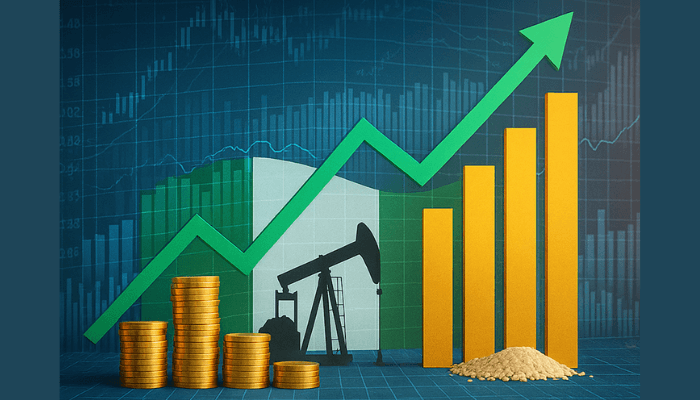“Yet it cautions that unless reforms yield visible improvements in everyday life, the government risks losing public trust.”
For policymakers in Abuja, the numbers look encouraging. Inflation is slowing. The naira has stabilised. Non-oil exports are climbing. The capital market is booming. Federal revenues have surged.
In macroeconomic terms, the painful reforms launched by President Bola Ahmed Tinubu in 2023 are starting to pay off.
But for ordinary Nigerians, the story is less clear. Food remains expensive, transport fares are high, and wages have only partially caught up with rising costs. The critical question now is whether macroeconomic gains can translate into microeconomic relief in households, businesses, and communities.
The Independent Media and Policy Initiative (IMPI), in its September 2025 policy statement, frames this as the ultimate test of reform. “Already, we can assert evidence of an economy that is creating jobs, expanding production, enhancing revenue and providing infrastructure,” the report argues.
Read also: Nigeria’s reforms painful but working, says UK envoy
Yet it cautions that unless reforms yield visible improvements in everyday life, the government risks losing public trust.
The clearest reform dividend has been in revenue. In July 2025, the Federation Account Allocation Committee (FAAC) shared N2.001 trillion among federal, state, and local governments, a record high. Total gross revenue available was N3.8 trillion.
This fiscal space has allowed states to raise wages and fund infrastructure without resorting to bank overdrafts. According to IMPI, 12 states have lifted minimum wages above the federal benchmark of N70,000, with some paying as high as N104,000. For workers in those states, take-home pay has risen significantly.
At the federal level, revenues grew 34.7 percent in H1 2025 compared with the same period in 2024. The Federal Inland Revenue Service (FIRS) collected N13.7 trillion, while the Nigerian Upstream Petroleum Regulatory Commission (NUPRC) earned N5.2 trillion. Customs added N2 trillion. Together, the “big three” agencies have already achieved over 58 percent of the government’s 2025 revenue target.
This revenue surge has lowered Nigeria’s debt-to-GDP ratio from 52 percent to 39 percent and reduced debt-service-to-revenue pressures. “Fiscal sustainability is no longer a distant goal,” IMPI notes.
The macro picture contrasts with recent household experience. In 2024, consumption collapsed under the twin shocks of subsidy removal and naira float. According to IMPI, household spending contracted by 42 percent in Q1 and almost 100 percent in Q2, year-on-year. Families cut food intake, postponed purchases, and focused on survival.
By 2025, however, signs of revival are visible. Statista projects consumer spending at $122 billion, with per capita disposable income rising to $604. Food and beverage spending per head is forecast at $319. The IMF and IMPI both cite these figures as evidence that household demand is recovering in line with slowing inflation and rising wages.
Still, the recovery is uneven. Urban households, especially those with public sector workers benefiting from wage increases, are faring better. Rural households, dependent on informal incomes and subsistence farming, remain vulnerable.
Read also: Can Nigeria’s reforms change lives by 2026 as election year looms?
One measure of household demand is the Purchasing Managers’ Index (PMI). Between October 2023 and July 2024, the PMI was below 50, signalling contraction. By October 2024, it crossed into expansion, reaching 54.2 in August 2025, its highest since April 2025.
The PMI shows rising new orders, modest job creation, and easing input costs. Companies report clearing backlogs for the first time in months. “Businesses are cautiously optimistic,” IMPI observes, citing expansion in services, construction, and agriculture, even as manufacturing lags.
For small firms, the recovery is tentative. Many survived the 2023–24 shocks by downsizing or suspending operations. Now, with FX stability and rising demand, some are reopening. Yet access to credit remains constrained by high interest rates.
Employment trends are harder to track. Formal job creation has been modest, concentrated in services and agribusiness. Informal work, which accounts for 60 percent of the labour force, remains fragile.
Wage increases in some states have lifted household incomes, but many Nigerians still work outside the formal system. Inflation, though slowing, has eroded real wages. For workers without wage adjustments, the disinflationary trend offers little comfort.
Labour unions remain sceptical. “The government celebrates FAAC allocations,” says a senior NLC official. “But for most workers, take-home pay does not take them home. Until living costs fall, reforms mean little.”
The NGX boom has created wealth effects for shareholders, pension funds, and institutional investors. Market capitalisation rose from $41.8 billion to $58.4 billion in the first eight months of 2025, unlocking $17.4 billion in gains.
For pension funds managing over N15 trillion in assets, equity gains strengthen balance sheets and future payouts. For middle-class investors, dividend resumption by firms like MTN and Nigerian Breweries signals recovery.
But the wealth effect is limited. Less than 5 percent of Nigerians invest directly in equities. For most households, market rallies remain distant. IMPI recognises this gap, arguing that inclusive financial markets are needed to link capital gains to broader welfare.
Read also: Inclusion for growth: Nigeria’s economic reforms must leave no one behind
To mitigate hardship, the federal government has expanded social interventions. Programmes include conditional cash transfers, youth employment schemes, and subsidised loans for SMEs. IMPI notes that these interventions are essential for cushioning vulnerable groups during the transition.
Yet implementation has been patchy. Targeting remains weak, and leakages persist. Critics argue that reforms disproportionately benefit corporations and states, while households rely on small, inconsistent transfers.
“Macro stability without social stability is fragile,” warns a development economist in Abuja. “Unless the poor are integrated into reform gains, resentment could grow.”
Despite the progress, risks abound. A poor harvest could reignite food inflation. Oil output, though improving, remains volatile. Global shocks from interest rate hikes to geopolitical crises could destabilise reserves and FX stability.
Politics adds another layer. With elections due in 2026, pressure for populist spending could derail fiscal discipline. Opposition parties already frame reforms as “anti-poor”, a narrative that could resonate if household relief lags.

